Dinner With Erdogan
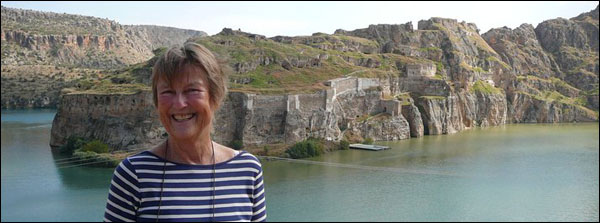
“Although some friends questioned the wisdom of traveling to Istanbul at a time of such volatility, when bombs seem to go off with disturbing frequency and nowhere is truly safe, I thought how refreshing it was to be able to celebrate something positive for a change.”—Diana Farr Louis
Eating Well Is The Best Revenge
By Diana Farr Louis
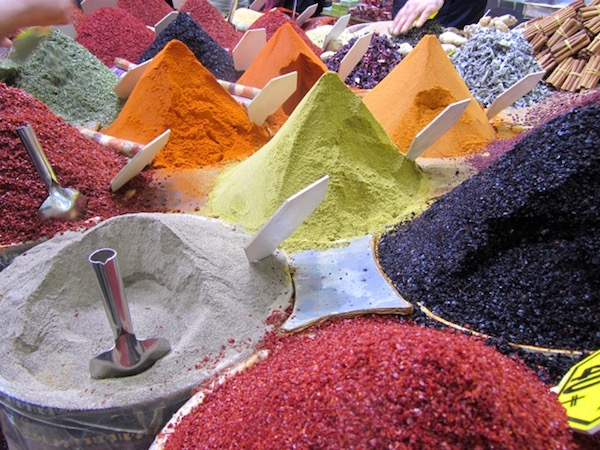
ATHENS Greece—(Weekly Hubris)—3/7/2016—The invitation slid into my inbox just two weeks before the event was to take place. The centerpiece was intriguing, a delicate Roman mosaic of a bird poised on the rim of a bowl, but the black print proved a bit hard to decipher against the brown background.
Upon close examination, the gist became plain: The city of Gaziantep in southeast Turkey had been incorporated into UNESCO’s network of creative cities because of its gastronomic wealth, and a gala dinner would be held to celebrate in Istanbul in the presence of the President.
On its own, it might have been easy to resist. Galas—not that I had ever attended one quite so illustrious—can be insufferably boring, with too many long-winded officials, lacklustre food, platitudes instead of conversation. And did one really want to be in the same room with The Man Who Would Be Sultan?
But subsequent emails held more tempting bait, such as tours, a Bosphorus boat ride, less formal meals, airfare, and a grand hotel thrown in, plus the biggest attraction of all—a chance to see a dear friend who has done so much to teach the West about Gaziantep.
When I first met Filiz Hosukoglu at my first Oldways Conference on Crete in 1997, she impressed me with her quiet manner, her knowledge—about food and about life—and her stories about Gaziantep, her ancient, walled home town, which naturally I had never heard of but vowed from then to visit.
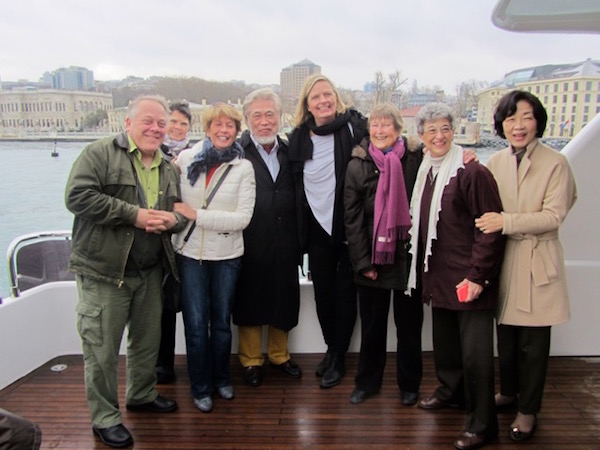
Although she had studied civil engineering in Istanbul, she helped Paula Wolfert and other recipe collectors and historians with research into Turkish foodways and gradually became involved with the municipality. For ten years, we didn’t see each other, but still kept in touch and, every now and then, she would send me emails about the city, food festivals, and a new guide to Southeastern Anatolia she’d worked on, that would make me drool. Finally, in 2010, an improbable invitation arrived: would I like to join an EU youth food workshop to be held in Gaziantep? Luckily, there was no age limit.
That was my dream come true and Gaziantep did not disappoint (see “Cooking & Feasting in Gazientep, Turkey,” November 2010). When our multinational group were not cooking ourselves, we were eating, visiting markets and crafts workshops, watching baklava being made in the place where it may have been invented, and even having our skin scrubbed off in a hammam.
We saw one of the world’s finest mosaic museums but we also noticed exceptional playgrounds, where the children themselves had been asked how they wanted them. Gaziantep may be one of the oldest continually inhabited settlements on the planet, but it’s very liveable and anthropocentric, thanks to enlightened, sensitive leadership.
This and the fact that it is widely considered the culinary capital of Turkey made it eligible for inclusion in the UNESCO network, along with Parma, Belem (Brazil), and Tucson (!), Arizona, among other places. But a creative city is not just one with a rich history or heritage, whether in the fields of design, film, crafts and folk art, music, literature, media arts, or gastronomy. It must also be innovative in its approach, sustainable, people-oriented, safe, and ecologically friendly. Once elected, it connects with sister cities to exchange ideas and experience.
Although some friends questioned the wisdom of traveling to Istanbul at a time of such volatility, when bombs seem to go off with disturbing frequency and nowhere is truly safe, I thought how refreshing it was to be able to celebrate something positive for a change.
And positive it was, for the guests were as varied and vibrant as the delectable spreads that greeted us at each meal. Food activists, food artists, and food writers mingled with representatives from Iran, Sweden, Brazil, Thailand, and South Korea (and I’m sure I’ve missed out several countries).
But we did not mingle much at the gala itself, where at least 600 people, mostly Turks, crowded into the Ciragan Palace, built by two short-lived sultans in the second half of the 19th century, and now an ultra-luxurious hotel. The chandeliers, painted ceilings, and glass banisters alone were worth the price of admission. Upstairs, leading to the immense dining room, all the décor related to Gaziantep—lovely copper pots, girls and waiters in local costume, and a gallery of all the specialties you’d find in the bazaar, including dangling garlands of colorful dried vegetables for stuffing.
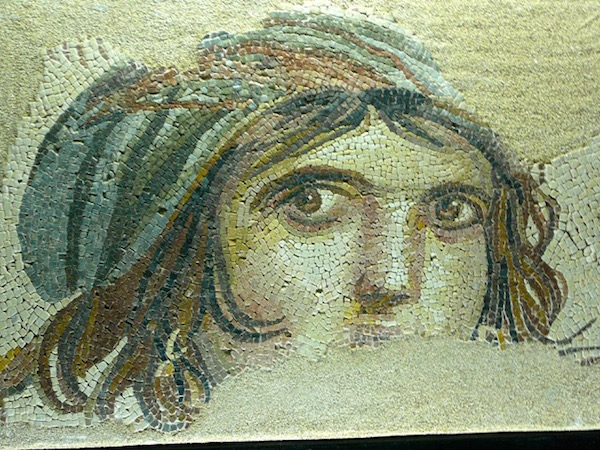
I lingered, admiring it all, but finally found my way to Table 44, where a solitary familiar face appeared among those of total strangers, mostly Asian. Ooops. My buddies seemed to be seated together elsewhere. I slipped in next to fellow American writer Barbara Gibbs Ostmann and tried to take photos of the delicious little plates in the centerpiece, which looked too pretty to eat. But it was difficult because strobe lights kept changing the colors from green to blue to lurid pink. Videos flashed before us on screens—of scenes from Gaziantep and its symbol, the Gypsy girl mosaic from the Greco-Roman town of Zeugma, its predecessor.
We waited and waited, somehow not daring to disturb the hors d’oeuvres, and sipping fruit juice because of course no alcohol is served at official functions in Turkey any longer. Eventually, a flurry of activity near the entrance signaled the arrival of the President. We’d been speculating whether he would take time out to attend this less than crucial event when so many pressing problems were demanding his attention, from the Ankara bombings, to the Syrian war, the Kurdish question, the refugees besieging the Syrian border (Aleppo is only two hours’ drive from Gaziantep) and departing for Greece.
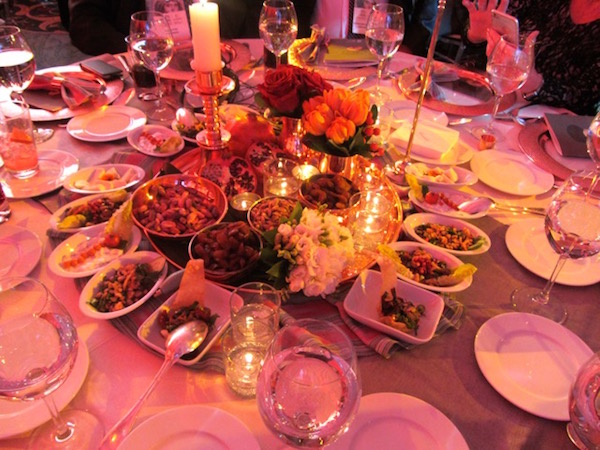
With his arrival, the talks started. I couldn’t get my headphones to work before the Mayor of Gaziantep, Fatma Sahin, had finished, but the regional governor mentioned that this former Silk Road city boasts 500 dishes, and that it would take well over a year to try them all. Thomas Curtis from UNESCO praised Gaziantep for using a culinary heritage that embraces so many cultures as a source of solidarity, and said that although its population of about 1.5 million has swelled by 350,000 Syrian refugees, it has managed to provide schooling for 98 percent of their children. He also saluted the women who traditionally make the food—“We must appreciate our mothers; God give grace to your hands”—and we learned that some 40 of them were in the kitchen preparing our feast.
When President Erdogan stepped up to the podium, his speech began and ended with predictable militancy—no different from at any other venue—so I won’t repeat it, but when he turned to the subject we were celebrating, he did make one very worthwhile suggestion: “Instead of having TV shows about cooking competitions and famous chefs, why don’t we have programs where grandmothers teach children how to make the traditional dishes that are part of their heritage?”
After the talks, the evening became really interesting, because the man sitting next to Barbara and me was no ordinary human being. He started out by asking us what we would do to change our own cities and, for the next two hours, we listened to his own refreshing ideas.
Professor Kwaak Young Hoon had arrived from Seoul with his beautiful but exhausted wife, Cherie, that evening—it was 5 a.m. for them—but he had plenty of energy and humor as he told us about designing Olympic installations, his Silk Road organization (which does not believe in borders), and his master plan for Lumbini, Buddha’s birthplace in Nepal, which will have the shape of a lotus flower, and include as much green space as built. But he wasn’t tooting his own horn. He was explaining his philosophy, inventing new words to describe it: Servenance instead of governance, Edutainment, Inperience rather than Experience, Mother organizations that foster preservation and nurturing (not the war and destruction of father organizations). A graduate of MIT and Harvard, with degrees in architecture, planning, political science, theology and maybe one more, he had taken Sam Huntington’s course on The Clash of Civilizations but much preferred to address “the Harmony of civilizations” and studiously avoided negativity of any kind.
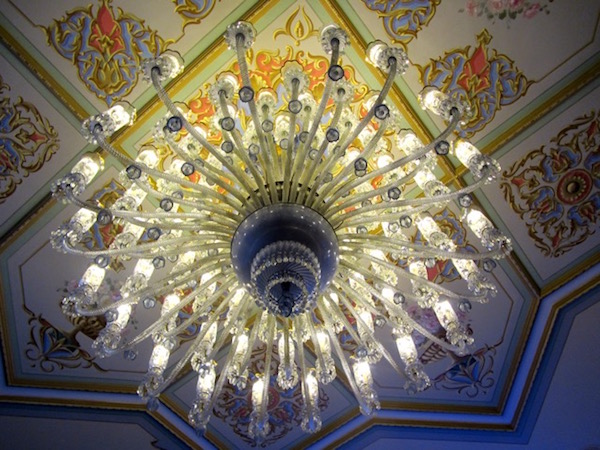
Not a single platitude was uttered during the entire meal, which was delicious and copious. But I can’t even tell you what was served because, although they gave us a beautiful menu with colored photos of each dish, it was all in Turkish. Stuffed veg, wrapped veg, yogurt soup with tiny kofte (chickpea-sized meatballs), lamb chops with freekah pilaf and quince—I think, ending with pistachio-filled baklava and other treats featuring the green nut for which Gaziantep is so famous.
The next day, our conversations continued on a boat up the Bosphorus, so interesting I barely noticed the palaces, yachts, fortresses, and lovely homes on both shores. Kwaak Young Hoon was joined by Fia Gulliksson, a dynamic Swedish architect/entrepreneur one of whose companies matches her name: Food In Action. She and Kwaak made the case for a new matriarchal structure for society. “We must push forward the female vision. We need the suffragette spirit. Why does our food system suck? Because 60 percent of what we eat is cultivated by women, but only 10 percent of the proceeds go to them, and they own only 1 percent of the land.”
There was lots more to ruminate upon, but I left with the message of Gaziantep, that food builds bridges to different cultures, different generations, and different heritages.
The Greeks on our gala weekend noted with sadness that our country does not as yet have a single creative city. But, inspired by Fia, I urge us all to take to heart the motto on her website (www.foodinaction.se): “My goal is to exceed all expectations and be the change you want to see in the world.”
Food for thought, indeed, so let’s eat, drink, and digest her words.
![]()
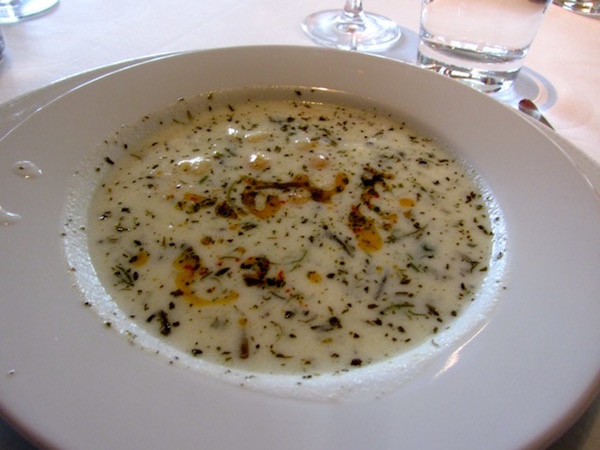
Recipe
Yogurt Soup with Swiss Chard/
Pazili lebeniye çorbasi
This recipe was kindly given to me by Aylin Öney Tan, author of A Taste of Sun & Fire, Gaziantep Cookery. It’s for yogurt soup, which comes in many versions. It was among the most unusual we sampled but also one of our favorites.
When Swiss chard comes out in spring, the green parts of the leaves are used to make various local dishes, reserving the stalks to make lebeniye çorbası. The name of this soup derives from the Arabic leben, meaning yogurt. Lebeniye çorbası is popular throughout Turkey’s southeastern region. In Gaziantep, they make this refreshing version with Swiss chard.
Serves 5-6
300 g (a bit more than half a pound) lean minced meat
1 cup rice
7 cloves garlic (crushed)
1/2 cup chickpeas
10-15 stalks of Swiss chard
5-6 cups water
3 cups strained yogurt
1 egg
1-1/2 teaspoons salt
1/2 teaspoon black pepper
1/4 teaspoon allspice
2 tablespoons butter
2 tablespoons dried mint
Soak the chickpeas overnight; then boil with salt and plenty of water until tender.
Remove the leafy parts of the Swiss chard and finely chop the white stalks.
Place the minced meat in a saucepan with 2 tablespoons of water, mix well then stir over a medium heat until all the liquid has evaporated and the minced meat becomes dry and crumbly. Add half the butter and the garlic and stir a few times.
Add the Swiss chard and stir until it softens. Add the spices, salt and water. Cover and bring to the boil, then add the washed rice and boiled chickpeas.
Beat the strained yogurt, egg and a little water in a small saucepan, place on low heat and stir constantly in the same direction until the mixture is fairly hot. Stir into the boiling soup, cook for a minute or so; then remove from the heat.
Melt the remaining butter in a small pan, add the mint and pour over the soup.
Note: If the yogurt is too sour for your taste you can add a little milk.

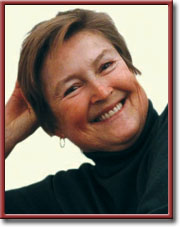
9 Comments
Will
My lord! What an experience! And what inspiration, too. Diana, I think it’s time to plan more youth excursions – you do so well! (The yogurt soup recipe is enticing. Must try it! Thanks!)
evi psathidou
Diana, what extraordinary encounters you had – both with food and people ! may you always convey to us with great gusto your travels and experiences with food and beyond. Thank you !
Mary Gladstone
How uplifting to read a positive article and to learn of people with hope and practical vision for the world’s cities. I’ve been on a journey: geographical, cultural and gourmet. Thank you dear Diana.
Athinadi
Like Mary said, you took us with you on your wonderful cultural, geographical and gourmet trip. As always, Diana – we see, we smell and we taste your stories! I never want them to end. Thank you!
diana
thank you, dears, so sweet of you to leave comments. I really appreciate it. Tesekkur ederim, as they say in Turkey.
Anita Sullivan
Diana, this piece makes me hope (realize?) that the forces for positive change are out there in the world simply doing their essential work, and the “establishment” (corporate and government) cannot keep it from happening. What an incredibly rich experience you summed up so well. Yumm!!
Christine L
Diana, what a wonderful follow-on from your trip. It really made the whole encounter come alive, good to hear you ventured forth in spite of all the upheavals happening. And what delicious flavours you conjured up!
diana
Yes, Anita, there were so many of what Helen Noakes called Little Points of Light, people getting on with doing good and positive things with or without encouragement from higher up. And Christine, thanks, reading your note on the day after yet another bombing in Istanbul — this one on the street that i got to know so well and where thousands of others spend so much time at all hours of the day or night — was really sickening.
Renee Voltmann
Absolutely fantastic article, Diana! BRAVA